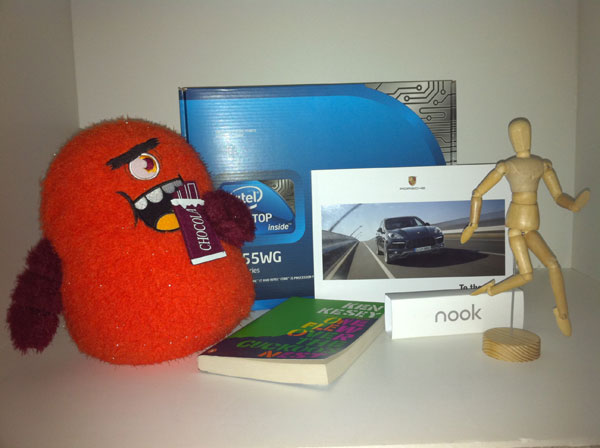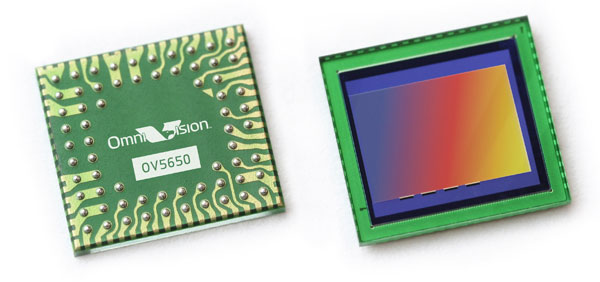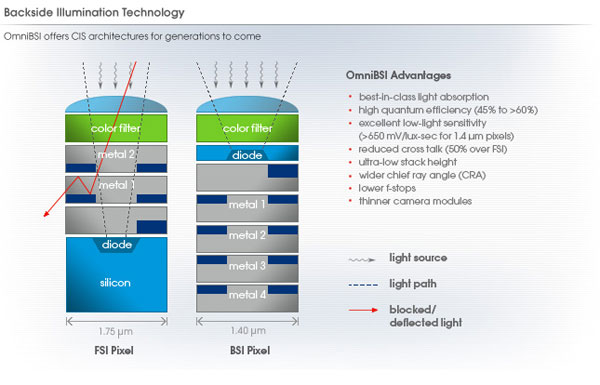Apple's iPhone 4: Thoroughly Reviewed
by Brian Klug & Anand Lal Shimpi on June 30, 2010 4:06 AM EST- Posted in
- Smartphones
- Apple
- iPhone 4
- Gadgets
- Mobile
Welcome to 2010, Apple Upgrades its Camera
The iPhone 4 is equipped with two cameras: a 5 megapixel camera with LED flash on the back of the phone and a VGA camera with no flash on the front. The LED flash works in both still and video modes. Like the EVO 4G, the iPhone 4‘s flash allows you to shoot in perfect darkness. If you’re filming a video in low light the LED will stay illuminated while you’re recording.

Taken with the iPhone 4 in total darkness
The same unfortunately can’t be said for the front facing camera on the 4. In anything but good lighting you’re going to get noise. It’s really only useful for FaceTime (or as an alternative to a mirror) and even then you need to be well lit for it to look decent.
Apple has opted for a 5 megapixel OmniVision sensor for the rear camera on the iPhone 4. What's interesting is that Apple has decided to bring backside illumination front and center with their marketing.
Backside illumination improves the sensitivity of CMOS and CCD detectors by reducing the amount of material in the path of incident light. In a frontside illuminated detector, a considerable amount of light is lost due to absorption that doesn't result in emission of an electron, in addition to reflection off pixel structures and electrical components near the frontside surface. Backside illumination greatly improves sensitivity by flipping the stack over. Instead of light having to pass through and possibly be reflected by metal structures, it is converted into electrons and read out by passing solely through silicon. Creating a backside illuminated part isn't as simple as flipping a sensor over, however, as manufacturers also generally thin the silicon light has to pass through before it can reach the photodiode. This further improves sensitivity and is generally accomplished through chemical etching in acid or by lapping (physically grinding) sensors at wafer scale.

OmniVision OV5650 - iPhone 4's rear camera SoC
Though backside illumination (BSI) improves quantum efficiency (how many photons are converted into electons), backside illumination is hugely important for another serious reason as well. Because the sensor is small at 4.6 mm by 3.4 mm, pixel size is also extremely small at just 1.75 microns square for the OV5650 in the iPhone 4 (state of the art sensors are 1.4 microns square, like those in the HTC Incredible's 8 MP sensor). Frontside illuminated parts generally have in the neighborhood of 10-15 microns of silicon before the active region of the photodiode where one wants photons to get converted to electrons. The result is that without backside illumination, pixels have a 10:1 ratio of height to length, you can visualize them as looking something like long square pillars. But that's a problem.
As photons are converted into electrons in that silicon, there's no guarantee that it will immediately travel down into the gate structure below to be read out by the camera. Electrons drift as they descend these columns, meaning that photons incident on one pixel don't necessarily map to the gate below. Because the smartphone camera sensors are so small, with a 10:1 ratio of height to size, the result is large amounts of so-called quantum blurring from electrons traveling into the gate structures of adjacent pixels. The result is a blurry image (and a decrease in MTF at the sensor level!), thus not representing the image that used to be incident on the sensor.
OmniVision and other smartphone CMOS sensor manufacturers thin that column down in an effort to come closer to having the pixel look more like a cube than a huge pillar. Ballpark numbers are between 3 and 6 microns, down from 10-15. The result is much more sensitive sensors that are higher resolution. While megapixels don't necessarily matter, neither does pixel size as much anymore; it's all about quantum efficiency, which is what engineers really care about.

OmniVision BSI - Courtesy OmniVision
The optical system of the iPhone 4 is difficult to characterize without disassembly, though the focal length is a bit shorter than previous iPhones. The result is that the photos are demonstrably wider angle. Backside illumination also allows for a bigger chief ray angle, higher numerical aperture (and thus lower f/#), but I won't bore you with the details.










270 Comments
View All Comments
Anand Lal Shimpi - Wednesday, June 30, 2010 - link
It honestly is basic differences in UI design. Unified settings panels (iOS) vs. per-app options and global settings (Android), much more freedom to configure how you want things displayed/presented, extending all the way down to the keyboard (Android) vs. a single Apple dictated way. These are the types of things that make the iPhone more of an appliance, basically if you like Apple's approach then there's no better device for you. A *lot* of users don't, and that's where Android comes in to play. I don't believe the power and flexibility of a PC-like device is a bad thing, but not everyone feels the same way. Take a die hard iPhone user and give them your Droid, you'll probably get the same response I did when I let some of those folks use the Nexus One or EVO 4G. It's really a preference thing, it reminds me a lot of the Mac vs. PC debates.And while i haven't played with the Droid, the scrolling issue is present on the Nexus One with live wallpapers disabled as well as enabled. Although enabling them makes it worse. The HTC Incredible is the first Android phone I've used that actually improved it, although didn't solve it completely.
I expect that in the next major Android update Google will fix it once and for all. I hope.
Take care,
Anand
JAS - Wednesday, June 30, 2010 - link
Yes, "more open, more configurable" is a double-edged sword. A comparison of Microsoft Windows and Macintosh OS X is apt in this regard.P.S. -- Can we advance beyond the juvenile label of "fanboy" when criticizing a person's like for a product?
bplewis24 - Wednesday, June 30, 2010 - link
Juvenile comes with the intent. I have the utmost respect for Anand and his opinion/reviews. If you take "fanboy" as a disparaging remark, fine, but it essentially means you have a bias or preference that obscures some of your objectivity.Brandon
The0ne - Wednesday, June 30, 2010 - link
As I've often expressed here, I like the reviews to not have any 1st person views. I don't care if one waited for 6hours for a phone. I don't want to hear any "this phone is the all to be". I just want a detail review of the phone and it's features. If one can qualify and/or quantify the differences with other products great. If you can't then don't, rather then having the innate urge to add your own opinions.Yes, the apple UI is more smooth, the experience is more enjoyable. The druid UI is a tad slower but by no means going to destroy or ruin anyone's experience. If you can't justify it, don't!
Lastly, the problem with 1st person perspectives being included in reviews and especially technical reports is that the reader will see it as favoritism. This is why absolutely NO credible technical and scientific review/report is written this way. I don't write my engineering tests and reports in 1st person. Just stick to the material and leave opinions out of it. This type of review ONLY happens online and sadly it's affecting technical and scientific materials as well.
Do the job, state the facts and tests and let the reader decide how to deal with it. Don't offer the reader any types of suggestion or persuasive comments. If you do include it, like other websites, in the editorial section or something similar.
kmmatney - Wednesday, June 30, 2010 - link
I wouldn't want to read reviews that just state facts. I'm an engineer/scientist and have written many peer-reviewed scientific papers. For tech reviews, though, I really appreciate user experience. There are just too many intangibles that can't be expressed by facts and tests. That's why I have been reading Anadtech for over 11 years - I appreciate the blend of techiness and user experience.totenkopf - Wednesday, June 30, 2010 - link
I have to agree with TheOne on this. Also, you can express "intangibles" without using the first person... If the iPhone's UI feels smoother than another phone then just say that and leave off the "I feel" bit.Remember that any statement comparing the iPhone to "Android" will have its flaws. You can only compare the iPhone 4 to other phones, not android. Any such statement will inherently be some form of generalization. Besides, Comparisons made with particular Android phones will be far more helpful as many android phones offer an experience distinct form any other Android phone.
It's really not that uncommon for iPhone users to play with an Android phone and really like it. Many of them actually seem quite surprised that they actually like it; some merely think that iOS is the only show in town as it has been the best for a long time. Widgets, in particular, offer a lot of customization and, perhaps just as importantly, personalization, that many iPhone users seem to appreciate. If used correctly, widgets can multiply the functionality of your phone many times over, and in some cases preclude running many apps at all. That said, setting up an android with just the way you like it and hunting down the newest and best apps and widgets can be an ongoing struggle. However, many people will enjoy it immensely if for no other reason than to make their phone that much better in their own eyes.
There! My experience with android without sounding too biased... I think ;) It certainly sounds better than "Android rulz 'cus widgets are soo good and apple doesn't even have them because apple is fail!"
John Sawyer - Thursday, July 1, 2010 - link
As an iPhone user for the past year, I can concur with your observation that many iPhone users would be impressed with the latest Android phones. I've tried the Evo for about ten minutes, and during that time, I did some web browsing, ran some apps, etc., and it was fast (even with a 3G connection), seemed polished, and I wouldn't complain too much if it was the only phone I had to use. If I had the chance to use it longer, I might start seeing its deficiencies, but a quick look, looked good.Though a week later, the iPhone 4 was released, and I was blown away by its display, which no other phone matches yet, though I'm somewhat biased about that since I like to be able to read tiny text.
The0ne - Thursday, July 1, 2010 - link
The problem with user experience is that it's just that and it affects how readers perceive the product. I don't mind really that reviews are done this way, but many are done extremely bad. Here are a few examples of comments people include in their reviews..."I let me wife play with it for a day or so and she loves it!" This is quite common for PMP player reviews.
"This is the best thing ever to come out on a phone..." Best thing is more or less an exaggeration. Way too many improper adjectives are used in reviews. Anandtech is no exception to this.
"I like it..." Okay, that means what, I should too?
strikeback03 - Thursday, July 1, 2010 - link
I disagree, in that I think the subjective "feel" of one phone (and OS) relative to another is largely subjective and can't be quantified in just plain numbers. Would you really feel better if he stated that "after observation with a high speed camera phone X illustrates a scroll with 5 frames and phone Y does so with 20" as opposed to "phone X is noticeably choppier"? Or say for example Sprint shipped a special edition EVO with 768MB RAM, we know that is 50% more, but would it actually make a difference in your interaction with the phone if you had less than 20 apps open?I have an HTC Touch Diamond, a WM 6.1 phone with TouchFlo 3d. None of the reviews I read before purchase adequately described how clunky the interaction between the TouchFlo plugin and the background OS is, or how poorly optimized WM6.1 is for a touchscreen, and certainly not how the speed of the device goes from marginal when new to completely unacceptable after a few months and requires a hard reset to restore.
ipredroid - Saturday, July 3, 2010 - link
What many fail to realize is with out opinion there would only be numbers and no reason to have site with user friendly technical data (a site like this). Everyone's opinion is biased or influenced by something, simply sticky by facts and zero emotion devoted towards every product is impossible. Many opinions itself is laced in bias preference for facts.I for one want as much information as possible not half the information.
Facts and opinions have and always will be better than just one of them. Would you rather have technical data about someones trip to Mt. Everest or an opinion. I would want both, so would everyone else or else you are missing facts.
Science and opinion go hand in hand. Cause and effect.